Cohen I.M., Kundu P.K. Fluid Mechanics
Подождите немного. Документ загружается.

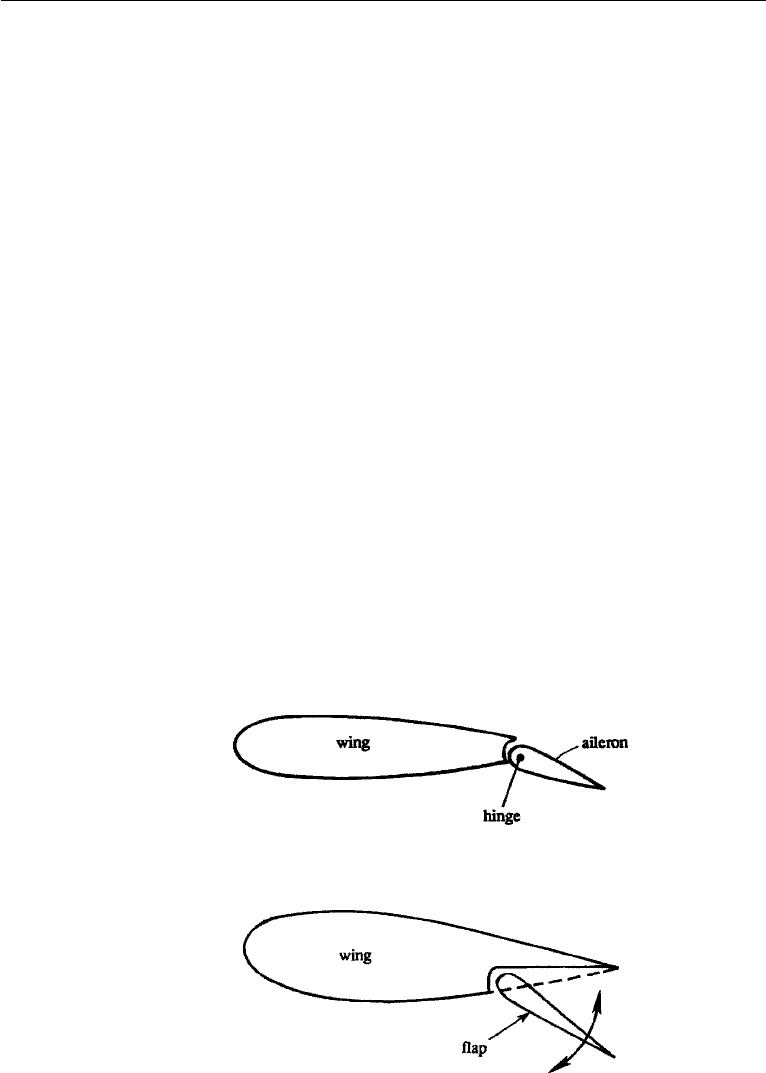
682 Aerodynamics
Control Surfaces
The aircraft is controlled by the pilot by moving certain control surfaces described in
the following paragraphs.
Aileron: These are portions of each wing near the wing tip (Figure 15.1), joined
to the main wing by a hinged connection, as shown in Figure 15.4. They move
differentially in the sense that one moves up while the other moves down.
A depressed aileron increases the lift, and a raised aileron decreases the lift,
so that a rolling moment results. The object of situating the ailerons near the
wing tip is to generate a large rolling moment. The pilot generally controls the
ailerons by moving a control stick, whose movement to the left or right causes
a roll to the left or right. In larger aircraft the aileron motion is controlled by
rotating a small wheel that resembles one half of an automobile steering wheel.
Elevator: The elevators are hinged to the trailing edge of the tail plane. Unlike
ailerons they move together, and their movement generates a pitching motion of
the aircraft. The elevator movements are imparted by the forward and backward
movement of a control stick, so that a backward pull lifts the nose of the aircraft.
Rudder: The yawing motion of the aircraft is governed by the hinged rear
portion of the tail fin, called the rudder. The pilot controls the rudder by pressing
his feet against two rudder pedals so arranged that moving the left pedal forward
moves the aircraft’s nose to the left.
Flap: During take off, the speed of the aircraft is too small to generate enough
lift to support the weight of the aircraft. To overcome this, a section of the rear
of the wing is “split,” so that it can be rotated downward to increase the lift
(Figure 15.5). A further function of the flap is to increase both lift and drag
during landing.
Figure 15.4 The aileron.
Figure 15.5 The flap.
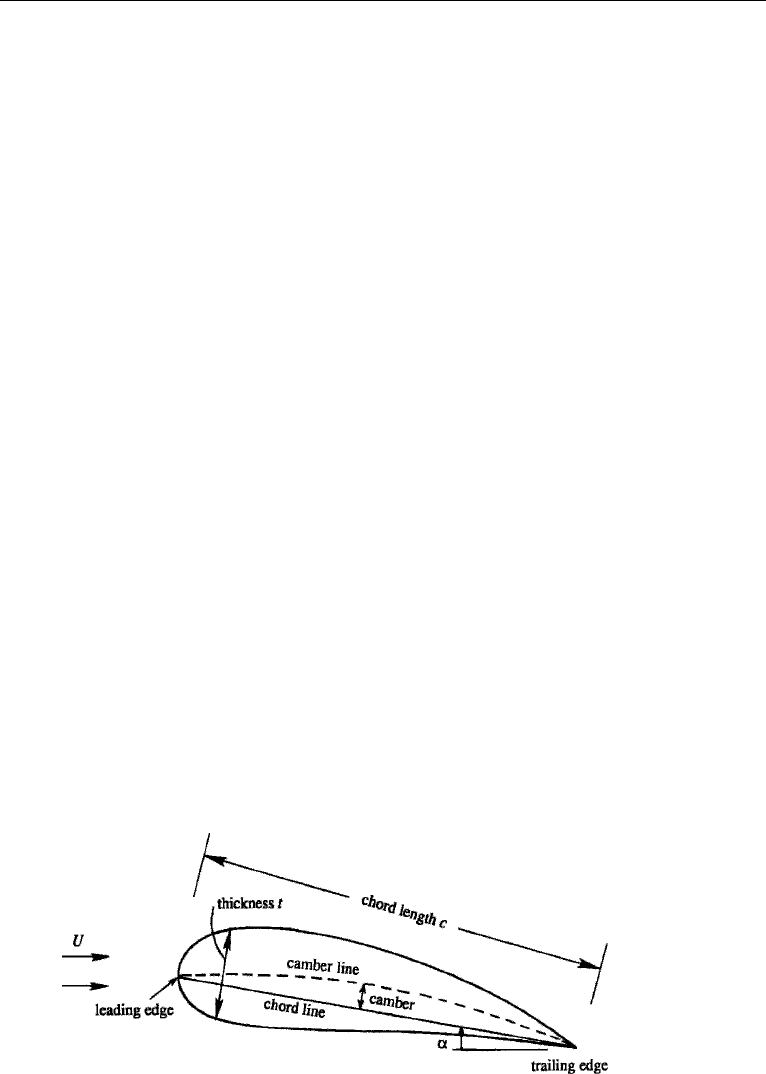
3. Airfoil Geometry 683
Modern jet transports also have “spoilers” on the top surface of each wing. When
raised slightly, they separate the boundary layer early on part of the top of the wing
and this decreases its lift. They can be deployed together or individually. Reducing
the lift on one wing will bank the aircraft so that it would turn in the direction of
the lowered wing. Deployed together, lift would be decreased and the aircraft would
descend to a new equilibrium altitude. Spoilers have another function as well. Upon
touchdown during landing they are deployed fully as flat plates nearly perpendicular
to the wing surface. As such they add greatly to the drag to slow the aircraft and
shorten its roll down the runway.
An aircraft is said to be in trimmed flight when there are no moments about
its center of gravity. Trim tabs are small adjustable surfaces within or adjacent to
the major control surfaces described in the preceding: ailerons, elevators, and rudder.
Deflections of these surfaces may be set and held to adjust for a change in the aircraft’s
center of gravity in flight due to consumption of fuel or a change in the direction of
the prevailing wind with respect to the flight path. These are set for steady level flight
on a straight path with minimum deflection of the major control surfaces.
3. Airfoil Geometry
Figure 15.6 shows the shape of the cross section of a wing, called an airfoil section
(spelled aerofoil in the British literature). The leading edge of the profile is generally
rounded, whereas the trailing edge is sharp. The straight line joining the centers of
curvature of the leading and trailing edges is called the chord. The meridian line of the
section passing midway between the upper and lower surfaces is called the camber
line. The maximum height of the camber line above the chord line is called the camber
of the section. Normally the camber varies from nearly zero for high-speed supersonic
wings, to ≈5% of chord length for low-speed wings. The angle α between the chord
line and the direction of flight (i.e., the direction of the undisturbed stream) is called
the angle of attack or angle of incidence.
Figure 15.6 Airfoil geometry.
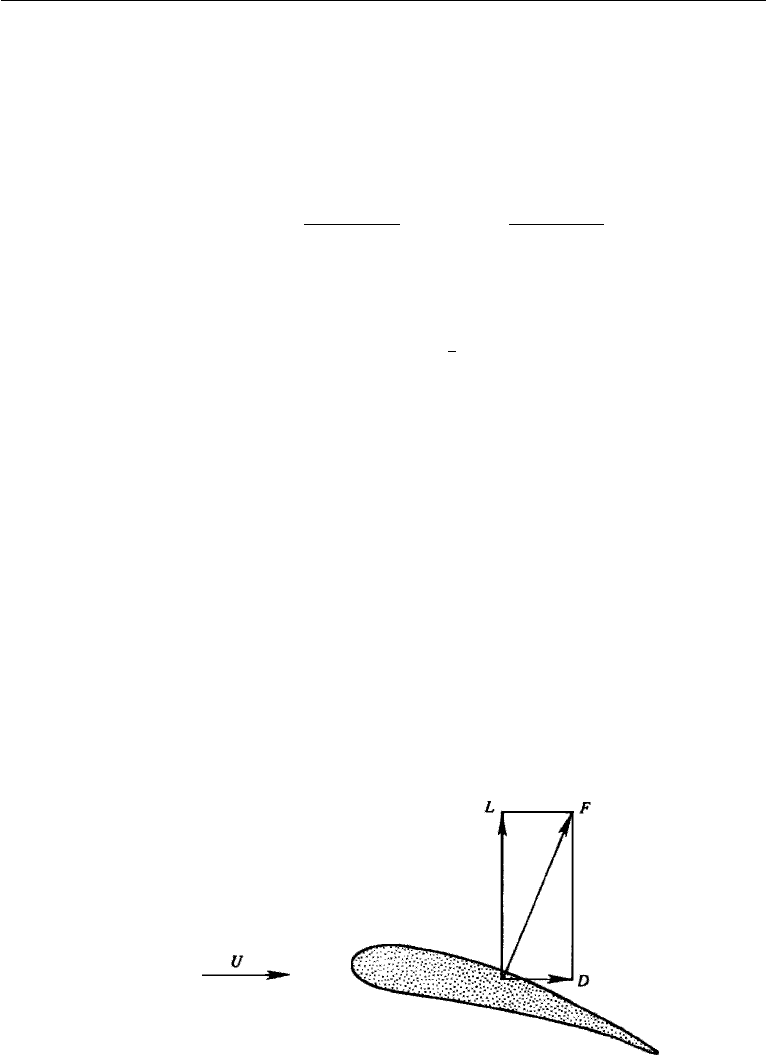
684 Aerodynamics
4. Forces on an Airfoil
The resultant aerodynamic force F on an airfoil can be resolved into a lift force L
perpendicular to the direction of undisturbed flight and a drag force D in the direction
of flight (Figure 15.7). In steady level flight the drag is balanced by the thrust of
the engine, and the lift equals the weight of the aircraft. These forces are expressed
nondimensionally by defining the coefficients of lift and drag:
C
L
≡
L
(1/2)ρU
2
A
,C
D
≡
D
(1/2)ρU
2
A
. (15.1)
The drag results from the tangential stress and normal pressure distributions on the
surface. These are called the friction drag and the pressure drag, respectively. The lift
is almost entirely due to the pressure distribution. Figure 15.8 shows the distribution
of the pressure coefficient C
p
= (p − p
∞
)/
1
2
ρU
2
at a moderate angle of attack. The
outward arrows correspond to a negative C
p
, while a positive C
p
is represented by
inward arrows. It is seen that the pressure coefficient is negative over most of the
surface, except over small regions near the nose and the tail. However, the pressures
over most of the upper surface are smaller than those over the bottom surface, which
results in a lift force. The top and bottom surfaces of an airfoil are popularly referred
to as the suction side and the compression side, respectively.
5. Kutta Condition
In Chapter 6, Section 11 we showed that the lift per unit span in an irrotational flow
over a two-dimensional body of arbitrary cross section is
L = ρU, (15.2)
where U is the free-stream velocity and is the circulation around the body. Relation
(15.2) is called the Kutta–Zhukhovsky lift theorem. The question is, how does a flow
develop such a circulation? Obviously, a circular or elliptic cylinder does not develop
Figure 15.7 Forces on an airfoil.
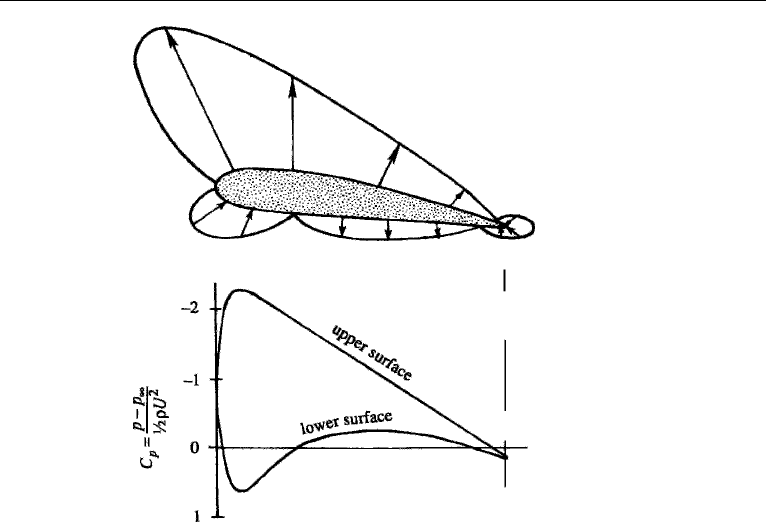
5. Kutta Condition 685
Figure 15.8 Distribution of the pressure coefficient over an airfoil. The upper panel shows C
p
plotted
normal to the surface and the lower panel shows C
p
plotted normal to the chord line.
any circulation around it, unless it is rotated. It has been experimentally observed that
only bodies having a sharp trailing edge, such as an airfoil, can generate circulation
and lift.
Figure 15.9 shows the irrotational flow pattern around an airfoil for increasing
values of clockwise circulation. For = 0, there is a stagnation point A located just
below the leading edge and a stagnation point B on the top surface near the trailing
edge. When some clockwise circulation is superimposed, both stagnation points move
slightly down. For a particular value of , the stagnation point B coincides with the
trailing edge. (If the circulation is further increased, the rear stagnation point moves
to the lower surface.) As far as irrotational flow of an ideal fluid is concerned, all
these flow patterns are possible solutions. A real flow, however, develops a specific
amount of circulation, depending on the airfoil shape and the angle of attack.
Consider the irrotational flow around the trailing edge of an airfoil. It is shown in
Chapter 6, Section 4 that, for flow in a corner of included angle γ , the velocity at the
corner point is zero if γ<180
◦
and infinite if γ>180
◦
(see Figure 6.4). In the upper
two panels of Figure 15.9 the fluid goes from the lower to the upper side by turning
around the trailing edge, so that γ is slightly less than 360
◦
. The resulting velocity
at the trailing edge is therefore infinite in the upper two panels of Figure 15.9. In the
bottom panel, on the other hand, the trailing edge is a stagnation point because γ is
slightly less than 180
◦
.
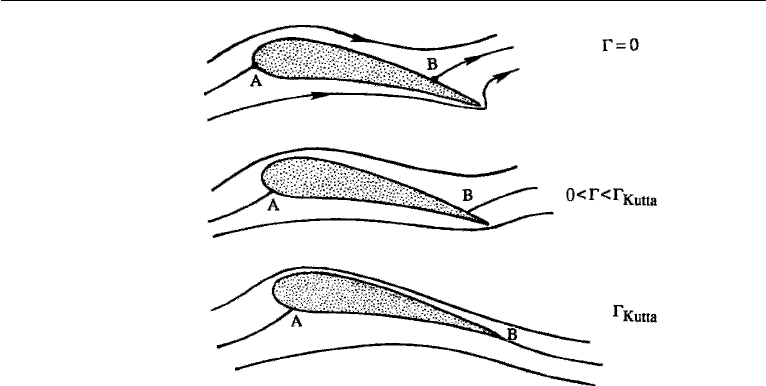
686 Aerodynamics
Figure 15.9 Irrotational flow pattern over an airfoil for various values of clockwise circulation.
Photographs of flow around airfoils reveal that the pattern sketched in the
bottom panel of Figure 15.9 is the one developed in practice. The German aero-
dynamist Wilhelm Kutta proposed the following rule in 1902: In flow over a
two-dimensional body with a sharp trailing edge, there develops a circulation of
magnitude just sufficient to move the rear stagnation point to the trailing edge. This
is called the Kutta condition, sometimes also called the Zhukhovsky hypothesis.At
the beginning of the twentieth century it was merely an experimentally observed fact.
Justification for this empirical rule became clear after the boundary layer concepts
were understood. In the following section we shall see why a real flow should satisfy
the Kutta condition.
Historical Notes
According to von Karman (1954, p. 34), the connection between the lift of airplane
wings and the circulation around them was recognized and developed by three per-
sons. One of them was the Englishman Frederick Lanchester (1887–1946). He was a
multisided and imaginative person, a practical engineer as well as an amateur mathe-
matician. His trade was automobile building; in fact, he was the chief engineer and
general manager of the Lanchester Motor Company. He once took von Karman for a
ride around Cambridge in an automobile that he built himself, but von Karman “felt a
little uneasy discussing aerodynamics at such rather frightening speed.” The second
person is the German mathematician Wilhelm Kutta (1867–1944), well-known for
the Runge–Kutta scheme used in the numerical integration of ordinary differential
equations. He started out as a pure mathematician, but later became interested in
aerodynamics. The third person is the Russian physicist Nikolai Zhukhovsky, who
developed the mathematical foundations of the theory of lift for wings of infinite span,
independently of Lanchester and Kutta. An excellent book on the history of flight and
the science of aerodynamics was recently authored by Anderson (1998).
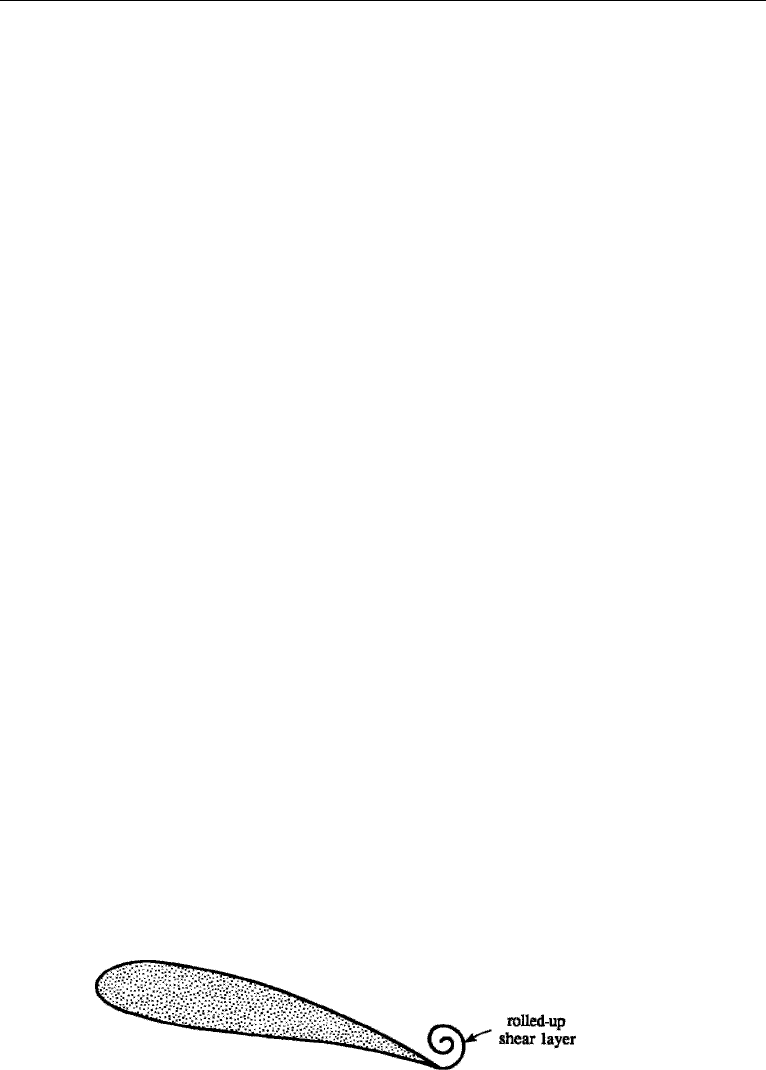
6. Generation of Circulation 687
6. Generation of Circulation
We shall now discuss why a real flow around an airfoil should satisfy the Kutta
condition. The explanation lies in the frictional and boundary layer nature of a real
flow. Consider an airfoil starting from rest in a real fluid. The flow immediately after
starting is irrotational everywhere, because the vorticity adjacent to the surface has
not yet diffused outward. The velocity at this stage has a near discontinuity adjacent
to the surface. The flow has no circulation, and resembles the pattern in the upper
panel of Figure 15.9. The fluid goes around the trailing edge with a very high velocity
and overcomes a steep deceleration and pressure rise from the trailing edge to the
stagnation point.
Within a fraction of a second (in a time of the order of that taken by the flow
to move one chord length), however, boundary layers develop on the airfoil, and the
retarded fluid does not have sufficient kinetic energy to negotiate the steep pressure
rise from the trailing edge toward the rear stagnation point. This generates a back-flow
in the boundary layer and a separation of the boundary layer at the trailing edge. The
consequence of all this is the generation of a shear layer, which rolls up into a spiral
form under the action of its own induced vorticity (Figure 15.10). The rolled-up shear
layer is carried downstream by the flow and is left at the location where the airfoil
started its motion. This is called the starting vortex.
The sense of circulation of the starting vortex is counterclockwise in Figure 15.10,
which means that it must leave behind a clockwise circulation around the airfoil. To
see this, imagine that the fluid is stationary and the airfoil is moving to the left.
Consider a material circuit ABCD, made up of the same fluid particles and large
enough to enclose both the initial and final locations of the airfoil (Figure 15.11).
Initially the trailing edge was within the region BCD, which now contains the starting
vortex only. According to the Kelvin circulation theorem, the circulation around any
material circuit remains constant, if the circuit remains in a region of inviscid flow
(although viscous processes may go on inside the region enclosed by the circuit).
The circulation around the large curve ABCD therefore remains zero, since it was
zero initially. Consequently the counterclockwise circulation of the starting vortex
around DBC is balanced by an equal clockwise circulation around ADB. The wing is
therefore left with a circulation equal and opposite to the circulation of the starting
vortex.
It is clear from Figure 15.9 that a value of circulation other than the one that
moves the rear stagnation point exactly to the trailing edge would result in a sequence
of events as just described and would lead to a readjustment of the flow. The only value
Figure 15.10 Formation of a spiral vortex sheet soon after an airfoil begins to move.
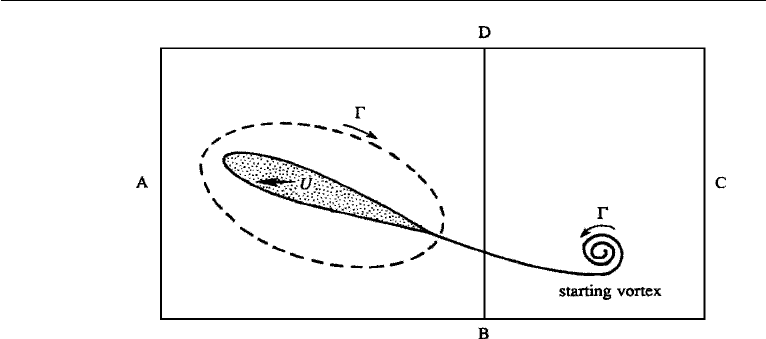
688 Aerodynamics
Figure 15.11 A material circuit ABCD in a stationary fluid and an airfoil moving to the left.
of the circulation that would not result in further readjustment is the one required by
the Kutta condition. With every change in the speed of the airflow or in the angle of
attack, a new starting vortex is cast off and left behind. A new value of circulation
around the airfoil is established so as to place the rear stagnation point at the trailing
edge in each case.
It is apparent that the viscosity of the fluid is not only responsible for the drag,
but also for the development of circulation and lift. In developing the circulation, the
flow leads to a steady state where a further boundary layer separation is prevented.
The establishment of circulation around an airfoil-shaped body in a real fluid is a
remarkable result.
7. Conformal Transformation for Generating Airfoil Shape
In the study of airfoils, one is interested in finding the flow pattern and pressure
distribution. The direct solution of the Laplace equation for the prescribed boundary
shape of the airfoil is quite straightforward using a computer, but analytically difficult.
In general the analytical solutions are possible only when the airfoil is assumed
thin. This is called thin airfoil theory, in which the airfoil is replaced by a vortex
sheet coinciding with the camber line. An integral equation is developed for the local
vorticity distribution from the condition that the camber line be a streamline (velocity
tangent to the camber line). The velocity at each point on the camber line is the
superposition (i.e., integral) of velocities induced at that point due to the vorticity
distribution at all other points on the camber line plus that from the oncoming stream
(at infinity). Since the maximum camber is small, this is usually evaluated on the
x–y-plane. The Kutta condition is represented by the requirement that the strength of
the vortex sheet at the trailing edge is zero. This is treated in detail in Kuethe and
Chow (1998, chapter 5) and Anderson (2007, chapter 4). An indirect way of solving
the problem involves the method of conformal transformation, in which a mapping
function is determined such that the arbitrary airfoil shape is transformed into a circle.
Then a study of the flow around the circle would determine the flow pattern around
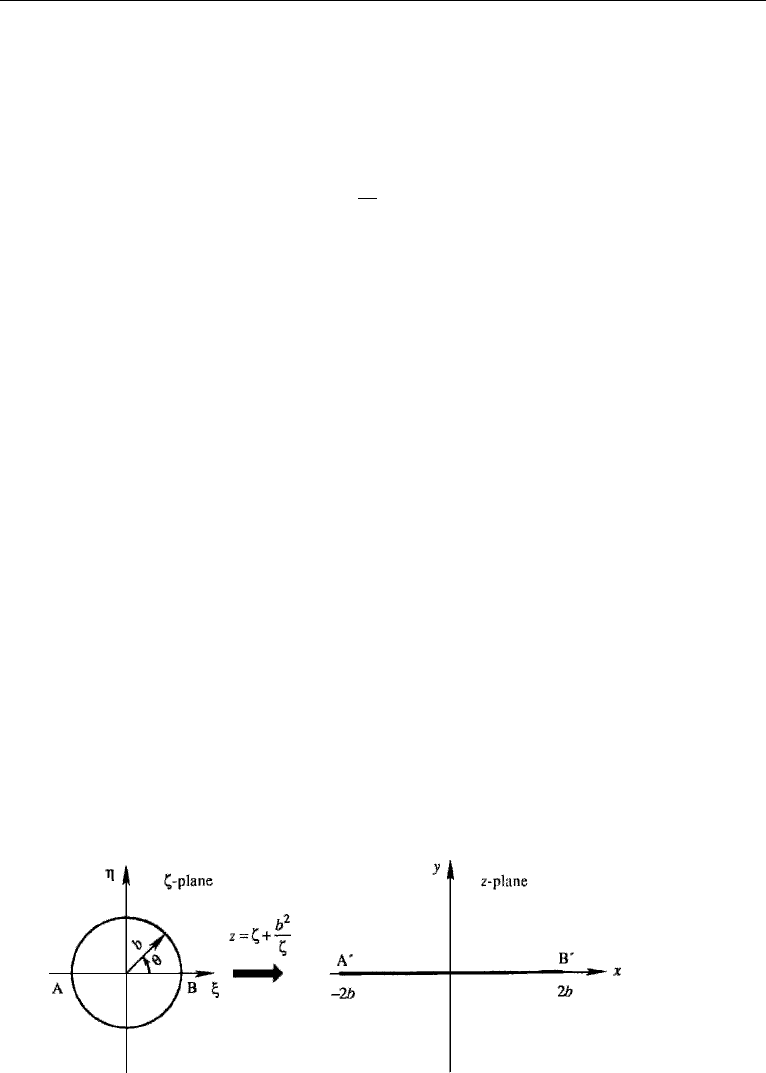
7. Conformal Transformation for Generating Airfoil Shape 689
the airfoil. This is called Theodorsen’s method, which is complicated and will not be
discussed here.
Instead, we shall deal with a case in which a given transformation maps a circle
into an airfoil-like shape and determines the properties of the airfoil generated thereby.
This is the Zhukhovsky transformation
z = ζ +
b
2
ζ
, (15.3)
where b is a constant. It maps regions of the ζ -plane into the z-plane, some examples
of which are discussed in Chapter 6, Section 14. Here, we shall assume circles of
different configurations in the ζ -plane and examine their transformed shapes in the
z-plane. It will be seen that one of them will result in an airfoil shape.
Transformation of a Circle into a Straight Line
Consider a circle, centered at the origin in the ζ -plane, whose radius b is the same as
the constant in the Zhukhovsky transformation (Figure 15.12). For a point ζ = be
iθ
on the circle, the corresponding point in the z-plane is
z = be
iθ
+ be
−iθ
= 2b cos θ.
As θ varies from 0 to π, z goes along the x-axis from 2b to −2b.Asθ varies from π
to 2π, z goes from −2b to 2b. The circle of radius b in the ζ -plane is thus transformed
into a straight line of length 4b in the z-plane. It is clear that the region outside the
circle in the ζ -plane is mapped into the entire z-plane. (It can be shown that the region
inside the circle is also transformed into the entire z-plane. This, however, is of no
concern to us, since we shall not consider the interior of the circle in the ζ -plane.)
Transformation of a Circle into a Circular Arc
Let us consider a circle of radius a (>b)intheζ -plane, the center of which is displaced
along the η-axis and which cuts the ξ -axis at (±b, 0), as shown in Figure 15.13. If a
Figure 15.12 Transformation of a circle into a straight line.
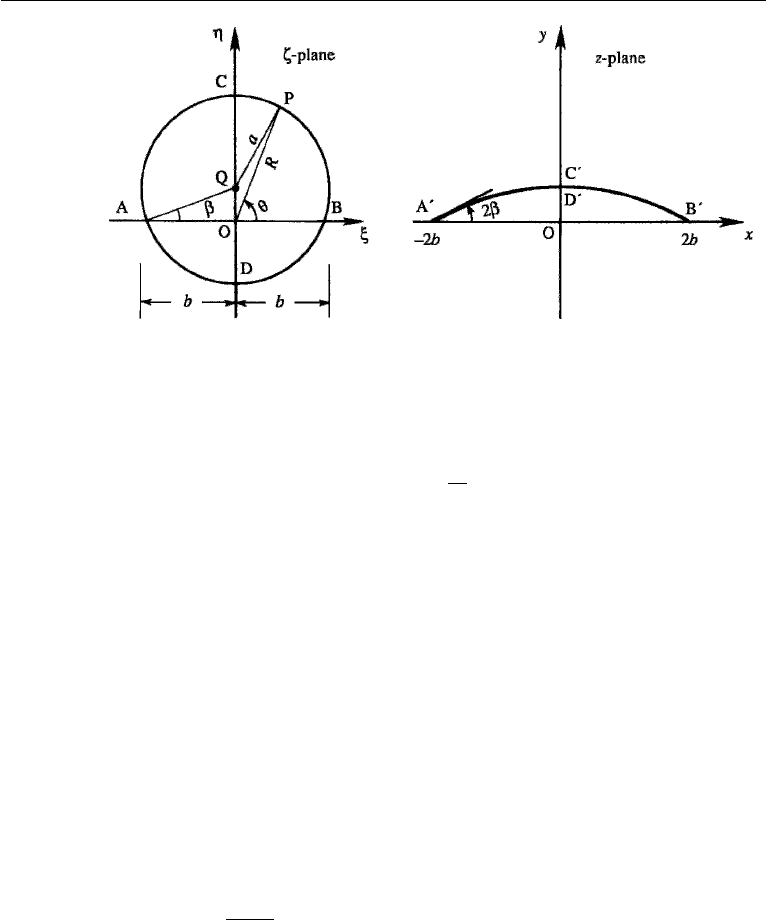
690 Aerodynamics
Figure 15.13 Transformation of a circle into a circular arc.
point on the circle in the ζ -plane is represented by ζ = Re
iθ
, then the corresponding
point in the z-plane is
z = Re
iθ
+
b
2
R
e
−iθ
,
whose real and imaginary parts are
x = (R + b
2
/R) cos θ,
y = (R − b
2
/R) sin θ.
(15.4)
Eliminating R, we obtain
x
2
sin
2
θ −y
2
cos
2
θ = 4b
2
sin
2
θ cos
2
θ. (15.5)
To understand the shape of the curve represented by equation (15.5) we must express
θ in terms of x, y, and the known constants. From triangle OQP, we obtain
QP
2
= OP
2
+ OQ
2
− 2(OQ)(OP) cos (Q
ˆ
OP).
Using QP = a = b/ cos β and OQ = b tan β, this becomes
b
2
cos
2
β
= R
2
+ b
2
tan
2
β − 2Rb tan β cos(90
◦
− θ),
which simplifies to
2b tan β sin θ = R − b
2
/R = y/sin θ, (15.6)
where equation (15.4) has been used. We now eliminate θ between equations (15.5)
and (15.6). First note from equation (15.6) that cos
2
θ = (2b tan β −y)/2b tan β, and
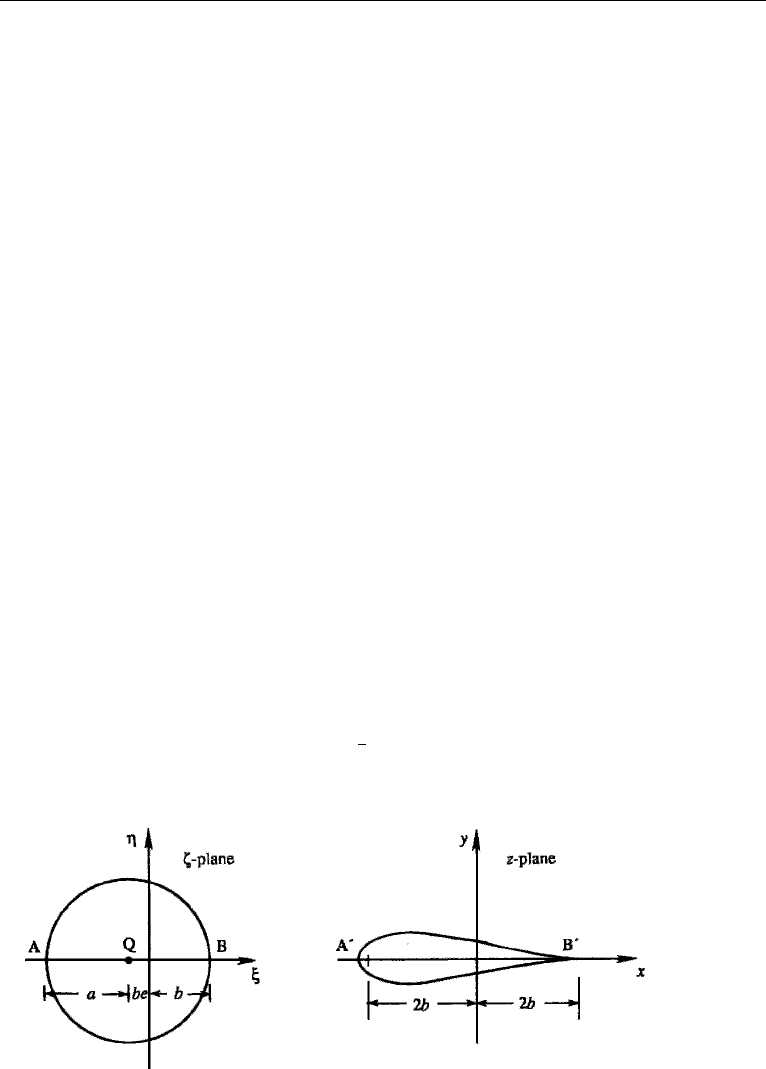
7. Conformal Transformation for Generating Airfoil Shape 691
cot
2
θ = (2b tan β −y)/y. Then divide equation (15.5) by sin
2
θ, and substitute these
expressions of cos
2
θ and cot
2
θ. This gives
x
2
+ (y + 2b cot 2β)
2
= (2b csc 2β)
2
,
where β is known from cos β = b/a. This is the equation of a circle in the z-plane,
having the center at (0, −2b cot 2β) and a radius of 2b csc 2β. The Zhukhovsky
transformation has thus mapped a complete circle into a circular arc.
Transformation of a Circle into a Symmetric Airfoil
Instead of displacing the center of the circle along the imaginary axis of the ζ -plane,
suppose that it is displaced to a point Q on the real axis (Figure 15.14). The radius of
the circle is a(>b), and we assume that a is slightly larger than b:
a ≡ b(1 + e) e 1. (15.7)
A numerical evaluation of the Zhukhovsky transformation (15.3), with assumed val-
ues for a and b, shows that the corresponding shape in the z-plane is a streamlined body
that is symmetrical about the x-axis. Note that the airfoil in Figure 15.14 has a rounded
nose and thickness, while the one in Figure 15.13 has a camber but no thickness.
Transformation of a Circle into a Cambered Airfoil
As can be expected from Figures 15.13 and 15.14, the transformed figure in the z-plane
will be a general airfoil with both camber and thickness if the circle in the ζ -plane is
displaced in both η and ξ directions (Figure 15.15). The following relations can be
proved for e 1:
c 4b,
camber
1
2
βc,
t
max
/c 1.3 e.
(15.8)
Figure 15.14 Transformation of a circle into a symmetric airfoil.
